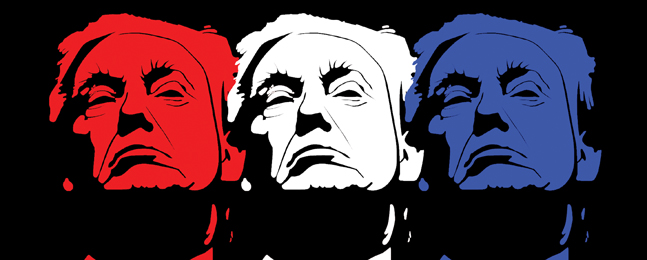Perspective
Political Science in the Age of Trump
Respected or reviled, the U.S. president is inspiring more college students to take politics classes and prompting professors to rethink how they teach.

Wikimedia Commons
by Isaac Rose-Berman ’22
As is probably true for most of my fellow students, my political consciousness doesn’t extend back much before President Donald Trump’s election in 2016. It’s hard for me to imagine a political world that isn’t divided or polarized, fueled by inflammatory presidential tweets and divisive policies. Trump has taken a sledgehammer to widely held beliefs about the nature and resiliency of American democracy.
Nationwide, this political ferment is stirring college students’ interest in political science. In an American Political Science Association survey, more than 40% of 383 U.S. political science departments reported their enrollments had increased between 2016-18 due to greater political interest, the 2016 election and President Trump. Brandeis is no exception. It’s beefing up its politics department through new faculty hires to respond to greater student interest.
I am a sophomore double majoring in politics and economics. I came to Brandeis to learn more about the world and think about solutions for global problems. But how are politics professors today coping with increased interest in their field as that field’s norms and long-standing beliefs about democracy are being upended, even tossed aside?
Brandeis politics professors say they are facing many challenges they have not faced in the past. They must persuade students that the study of politics requires much more than reading Twitter or BuzzFeed. They must prevent political disagreements in the classroom from descending into screaming matches. They must also strive to keep their own biases out of the classroom.
Daniel Kryder, the Louis Stulberg Chair in Law and Politics, has taught a course called The American Presidency for many years. He says students can better understand the Trump presidency if they take a long-term, critical perspective on how the presidency and its relationship with other parts of the American political system have developed.
Kryder helps students recognize which aspects of Trump’s presidency should be viewed in terms of continuity, and which should be understood as examples of innovation and disruption. He urges students to categorize Trump’s decisions as “strategic,” “ideological” or merely “instinctual.”
“All presidents try to exploit the structural advantages of the executive,” Kryder says. “Students must therefore think critically about whether and how Trump may be discarding or bending norms.”
Assistant professor Zachary Albert, who started teaching at Brandeis last fall, sees the Trump presidency as a pedagogical gold mine, not least because more students are interested in politics. In his class Elections in America, Albert tries to make “political theories, concepts and research relatable and topical,” he says.
Of course, conventional political theories don’t always hold true anymore. For example, before 2016 most people believed political parties and campaign contributions have a big impact on decisions about who gets a party’s nomination. Yet Trump won the presidency after record few endorsements, explicit repudiation by his party’s political elites and far less money than his opponent. As a result, many have begun to question whether these things still matter.
Though the Trump presidency is challenging political orthodoxy, Albert believes greater skepticism about the political process is energizing both students and professors. The uncertainty leads to “puzzles people are interested in resolving,” he says.
Lecturer Lucy Goodhart, who teaches the course Red States, Blue States: Understanding Contemporary American Voters and Parties, sees the increasing political polarization as a critical problem for American democracy as well as a force reshaping the way politics is taught. She says she often avoids mentioning Trump in class because he tends to trigger emotional responses in students, which makes discussions less analytical. She doesn’t have many pro-Trump students in her class, so, without careful monitoring, discussions could easily devolve into Trump and Trump-supporter bashing.
To avoid debating Trump’s particular merits or demerits, Goodhart focuses on the trends and factors that have shaped contemporary American politics, thereby encouraging students to adopt the intellectual detachment a good social scientist must have.
Associate professor Jill Greenlee, who has taught a class called The Rise of Trump, also points to the difficulties of teaching politics in the age of Trump because of the number of topics that evoke strong emotions in students. To get students to engage with the issues and each other civilly, respectfully and objectively, she tries to stay attuned to students’ personal sensitivities and interpersonal dynamics. At the beginning of a semester, Greenlee sometimes holds an explicit discussion about how conversations should unfold, and how students should address and treat one another. When the rules of engagement are discussed in advance, she says, students find it easier to engage with their peers and the class material productively.
The Trump presidency has changed the challenges but also the payoffs of teaching politics. Professors recognize that, in an era when politics has become increasingly contentious and high-stakes, they have a special responsibility to get their students to think clearly about American democracy and politics around the globe.
In other words, their mission remains the same.
New York City native Isaac Rose-Berman is an editor of the Brandeis Journal of Politics and captain of the table tennis club.
